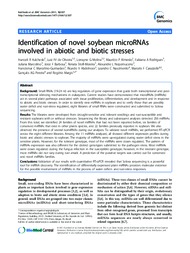Identification of novel soybean microRNAs involved in abiotic and biotic stresses.
Identification of novel soybean microRNAs involved in abiotic and biotic stresses.
Autoria: KULCHESKI, F. R.; OLIVEIRA, L. F. V.; MOLINA, L. G.; ALMERAO, M. P.; RODRIGUES, F. A.; MARCOLINO, J.; BARBOSA, J. F.; STOLF-MOREIRA, R.; NEPOMUCENO, A. L.; MARCELINO-GUIMARÃES, F. C.; ABDELNOOR, R. V.; NASCIMENTO, L. C.; CARAZZOLLE, M. F.; PEREIRA, G. A. G.; MARGIS, R.
Resumo: Background: Small RNAs (19-24 nt) are key regulators of gene expression that guide both transcriptional and posttranscriptional silencing mechanisms in eukaryotes. Current studies have demonstrated that microRNAs (miRNAs) act in several plant pathways associated with tissue proliferation, differentiation, and development and in response to abiotic and biotic stresses. In order to identify new miRNAs in soybean and to verify those that are possibly water deficit and rust-stress regulated, eight libraries of small RNAs were constructed and submitted to Solexa sequencing. Results: The libraries were developed from drought-sensitive and tolerant seedlings and rust-susceptible and resistant soybeans with or without stressors. Sequencing the library and subsequent analyses detected 256 miRNAs. From this total, we identified 24 families of novel miRNAs that had not been reported before, six families of conserved miRNAs that exist in other plants species, and 22 families previously reported in soybean. We also observed the presence of several isomiRNAs during our analyses. To validate novel miRNAs, we performed RT-qPCR across the eight different libraries. Among the 11 miRNAs analyzed, all showed different expression profiles during biotic and abiotic stresses to soybean. The majority of miRNAs were up-regulated during water deficit stress in the sensitive plants. However, for the tolerant genotype, most of the miRNAs were down regulated. The pattern of miRNAs expression was also different for the distinct genotypes submitted to the pathogen stress. Most miRNAs were down regulated during the fungus infection in the susceptible genotype; however, in the resistant genotype, most miRNAs did not vary during rust attack. A prediction of the putative targets was carried out for conserved and novel miRNAs families. Conclusions: Validation of our results with quantitative RT-qPCR revealed that Solexa sequencing is a powerful tool for miRNA discovery. The identification of differentially expressed plant miRNAs provides molecular evidence for the possible involvement of miRNAs in the process of water deficit- and rust-stress responses.
Ano de publicação: 2011
Tipo de publicação: Artigo de periódico
Unidade: Embrapa Soja
Palavras-chave: Deficiência hídrica, Gene expression, Gene marcador, Soil water deficit, Soja, Soybeans
Observações
1 - Por padrão são exibidas publicações dos últimos 20 anos. Para encontrar publicações mais antigas, configure o filtro ano de publicação, colocando o ano a partir do qual você deseja encontrar publicações. O filtro está na coluna da esquerda na busca acima.
2 - Para ler algumas publicações da Embrapa (apenas as que estão em formato ePub), é necessário ter, no celular ou computador, um desses softwares gratuitos. Sistemas Android: Google Play Livros; IOS: iBooks; Windows e Linux: software Calibre.
Acesse outras publicações
Acesse a Base de Dados da Pesquisa Agropecuária (BDPA) para consultar o acervo completo das bibliotecas da Embrapa.

